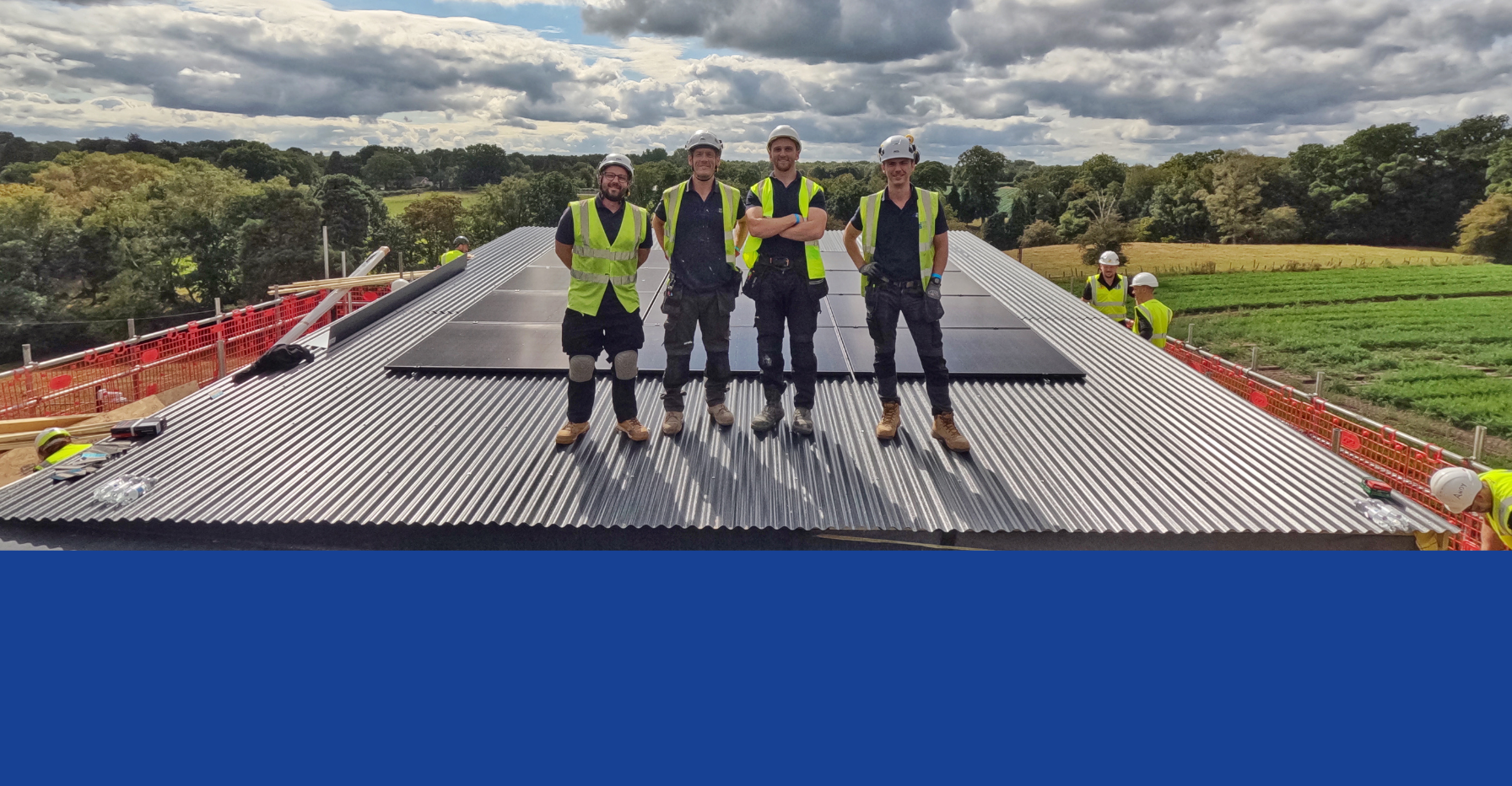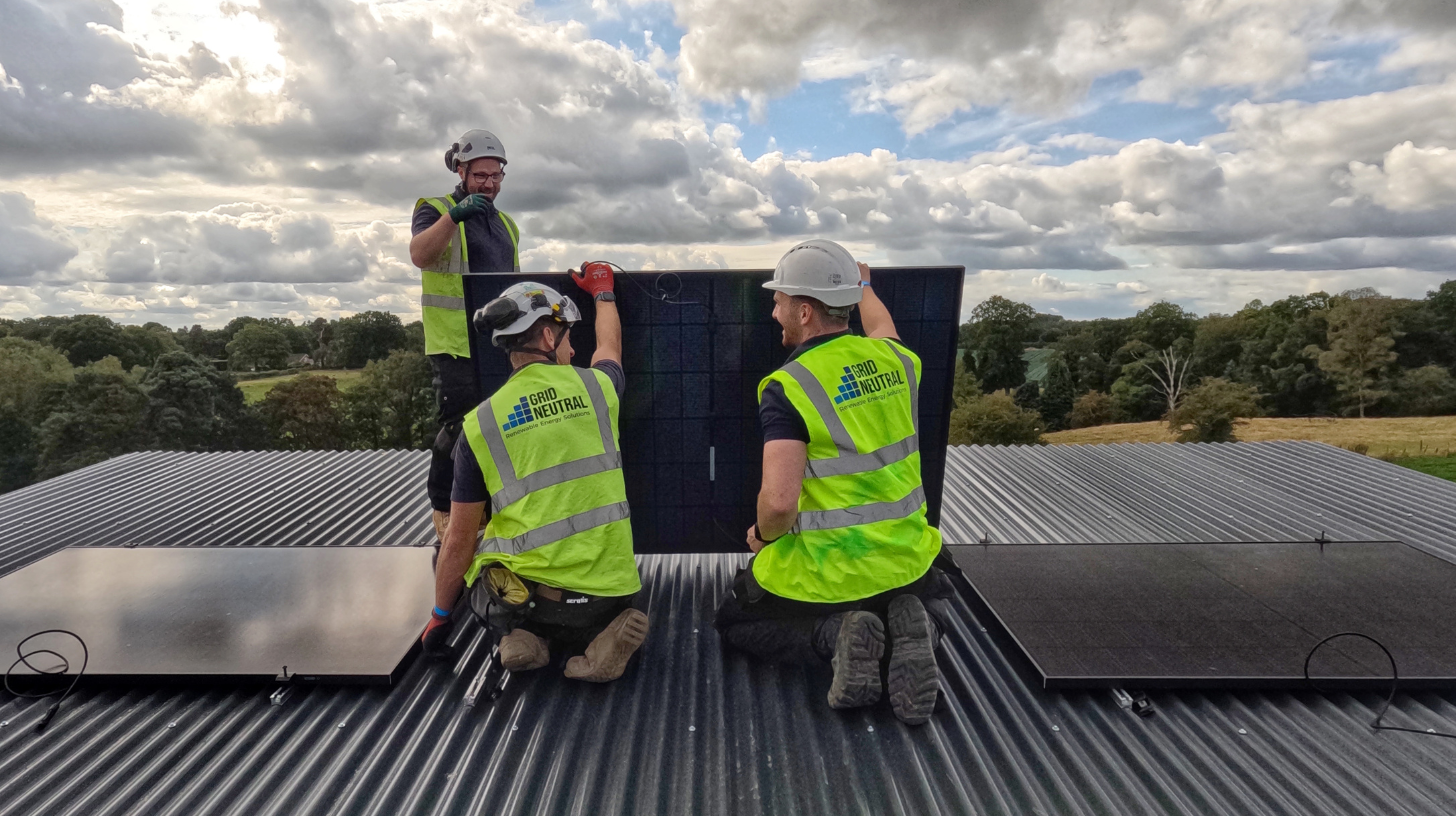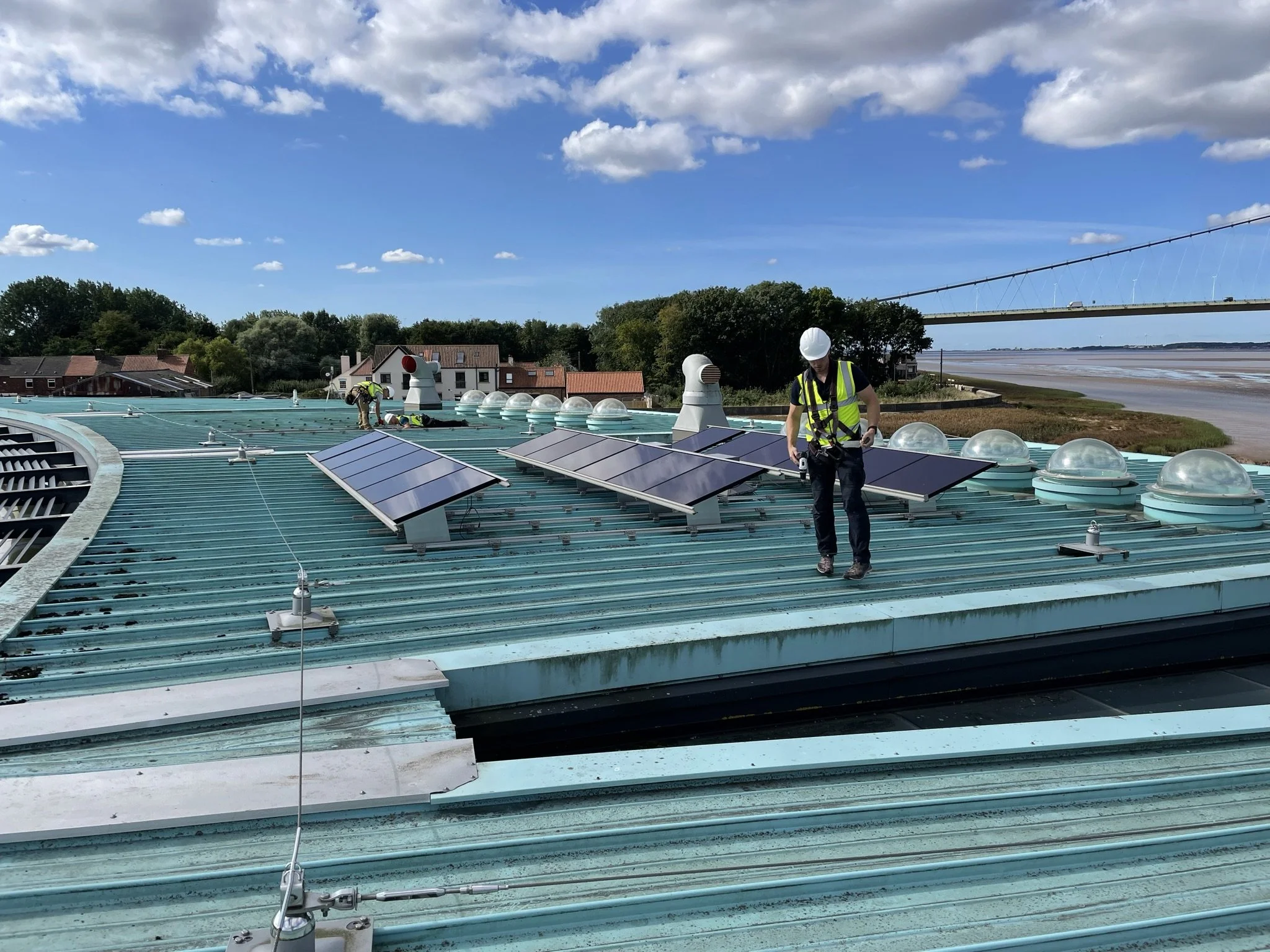FAQs
Hello, World!
-
Solar PV systems work by harnessing sunlight and converting it into electricity through photovoltaic cells. These cells are typically made from semiconductor materials like doped silicon. When sunlight hits these cells, it generates a small electric current, by coupling multiple cells together – as many as 72 in modern panels, we get a sizeable electrical current.
This current is DC (direct current), rather like a battery which is completely the wrong from – it’s also at the wrong voltage for it to be of any use in our home. So we connect a string of these panels to an Inverter, which converts the DC power into alternating current (AC) at the right voltage, making the energy your panels produce compatible with your home's electrical system. The generated electricity can power your home or be fed back into the grid.
Modern Solar PV systems in homes are usually equipped batteries. These store excess energy for use when the panels aren’t quite making as much power as your home needs – whether this is at night, or during the day when you have the kettle on. These batteries can also store energy from the grid at night-time when energy is cheaper – for use during the daytime when you need it. Particularly useful during dull, grey and short winter days.
-
Solar energy offers a multitude of benefits. It's a clean and renewable source of power, reducing your carbon footprint and reliance on fossil fuels. By generating your electricity, you can expect some significant savings on your energy bills and achieve long-term savings. Solar panels also require minimal maintenance and are now starting to increase the value of your property. Additionally, using solar energy contributes to a more sustainable future by reducing greenhouse gas emissions.
-
The suitability of your location for solar installation depends on factors such as the size of the roof space available, shading from nearby structures or trees, and the angle and orientation of your roof. For overall production, a south-facing roof with minimal shading is generally thought of as best, however an east/west split can actually be better for savings – a split array will tend to generate a broader spread of useful energy throughout the day.
-
We start by discussing what your requirements are, and what you know of your energy consumption. For domestic systems we use MCS approved Solar PV design software that accurately models system performance to gove you an idea of what savings you can expect to make.
For commercial and industrial systems we utilise an advanced, desktop-based Solar PV design software. We build an accurate 3D replica of your building, map out shading, and optimise panel placement according to the needs of our client. The software then models generation over a year in 5-minute intervals. By comparing this with energy usage data, we can provide our clients with a report with which decisions can be made. If you have access to your Half-Hourly (HH) energy usage data (if only for a short period of data), we can further boost the accuracy of these projections. Useful information when you need it – get in touch to find out more!
-
Batteries are seen as a crucial component of modern Solar PV systems. In the past, everything was about numbers – how much can you generate in order to receive the most amount of revenue from the Feed-in Tariff. In the modern context of higher energy prices, the drive for energy independence etc. it is about savings – this is where battery storage really helps. A battery storage system allows you to store excess energy generated by your solar panels during the day. The battery will then power your house when generation doesn’t keep up with demand (as it would on dull days) or during evenings/night times. You can also charge your battery with off-peak electricity with “time-of-use” or Economy 7 type tariffs for use during the day time in winter when generation will be much lower. Modern battery storage systems such as those from GivEnergy or MyEnergi are very flexible, and can be tweaked to charge and discharge at certain times, or even to export to the grid to make use of generous time-specific export rates that tariffs such as Outgoing Agile or Flux from Octopus will give you.
-
This depends on several factors, including what you would actually like to achieve with your system, Back-up power solutions can vary from a simple 13A socket that you can plug an extension cable in to, through to whole-house back-up systems that are so effective you may not even know that the grid is down. We can offer a range of solutions tailored to your needs and budget.
-
The cost of a solar PV system can vary based on factors like the size of the system, the type of solar panels used – warranty periods and country of origin will affect this, installation costs, and any additional components like battery storage, optimisers etc. As a guideline, costs for smaller residential systems start at about £1,200/kW 3-4kW is about the average size. This drops to around £500/kW as we get close to the 200kW mark on larger commercial systems.
-
Item There are many factors that affect the installation time on a PV system – with size and complexity being up front and centre. A straightforward residential installation will usually take two days – more for something especially large or complex. Commercial installations are altogether different, we can install 100-120kW/week on trapezoidal factory roofs.
-
Solar PV systems are relatively low-maintenance, and we can remotely check-in on your battery and inverter to see that everything is functioning as it should – so there’s not much that you’ll need to do. However, periodic cleaning – such as that done by window cleaners will help keep the panels free of any debris that may hinder performance. One should also keep an eye on the shading caused by the growth of nearby trees. Additionally, annual inspections of the system's components and connections are recommended to identify and address any issues promptly.
-
The Smart Export Guarantee (SEG) is a government mandated billing arrangement that allows you to earn a small amount of money from your energy company for excess electricity your solar system produces and feeds back into the grid – this will happen on even with the smallest PV systems on long, sunny summer days. Generally, it is the case that these payments are separately administered from your normal utility bill and will appear as a credit.
-
The ROI of a solar PV system depends on factors like your location, energy usage, the cost of electricity, and any available incentives. The shortest payback for a system we have installed was 14 months (for a large commercial system), whilst a residential user can expect a ROI period of 7-10 years. We would recommend evaluating both the short-term and long-term financial benefits when considering a Solar PV installation. With that said, it should be considered that there are some things you simply can’t put a price on – such as the feeling of running your home on 100% home-grown electricity when you start switching appliances on during a sunny day.
-
Yes there are, but…
They’re limited for residential installations unless your household meets certain social criteria, such as various benefits, access to pension credits etc. You also need to be off mains gas. Unfortunately, this eliminates perhaps 90% of UK households. This picture changes for business however; depending on your local authority, you may be able to receive a grant to cover up to 25% of the cost of an installation- such programs significantly reduce the upfront cost of installing a solar PV system at your business premises.
-
Solar panel warranties typically include a product warranty that covers defects and a performance warranty that guarantees a certain level of energy production over a specified period. These warranties vary by manufacturer and can range from 10 to 25 years or more. We’re quite passionate about supplying panels from reputable manufacturers such as QCells and Eurener - who offer long 25-Year product warranties, and similar duration linear performance warranties.
Word to the wise: don’t get confused with product and performance warranties. Many installers will claim that their panels have 25 year warranties in their advertising, though the subsequent small print will reveal the “Tier 1, Premium Panel with 25 year Warranty” that you’ll receive will perhaps instead have a 12 year product warranty.
We can offer cheaper options, but at Grid Neutral, we believe that quality components with long warranties form the basis of a quality installation – in line with our ethos, we owe it to future generations to fit equipment that’s going to last a long, long time.
-
Solar panels are designed to withstand a range of weather conditions, including hail and high winds – but a falling TV ariel, chimney pot or tree branch caused by weather can lead to damaged panels. They are tested to meet industry standards and are built to be durable and resilient. The pertinent element of the question here lies with the way that the system is mounted – we will take in to account the prevailing weather conditions near a potential installation site to help determine whether an uplift in fixing size/quantities etc would be required.
-
In a standard grid-tied (i.e. without battery) solar PV system, the system will shut down during a power outage for safety reasons – it’s a legal requirement under the G98 & G99 Electrical Engineering Regulations. However, if you have a battery storage system installed, you can use it to power essential appliances during outages providing the additions have been made during the installation phase. These additions vary from house to house but at the least an Emergency Power Supply (EPS) will consist of installing an earth rod and simple RCD-protected socket that you can run an extension cable from to power lights, routers etc.
The requirements of our customers vary, and we have numerous options that we can provide – a whole-house un-interruptable power supply (UPS) is one of them. Please get in touch to discuss!
-
Easy, choose us!
But really, what we’d recommend is looking around, asking friends and family, browsing local neighbourhood WhatsApp/Facebook groups and forums etc. to seek the experience of others and find out whether they have recommendations. You should look for a company that has a proven track record of delivering quality installations, has positive customer reviews, all the relevant certifications – including MCS.
Ask questions, do your research, and make sure you fully understand the ins-and-outs of Solar Panel Installations – do you want a sales rep or a solar engineer to visit your home to discuss your system? Scrutinise their proposal. Request quotes from multiple companies - don't hesitate to ask questions about their processes and warranties.
Be wary of a lot of new start-ups advertising with stock photos (the giveaway to this is silver framed solar panels on houses that are clearly not British housing stock, and no pictures of internal works such as the inverter/battery and electrical installation). It is easy for us to spot poor quality installations on the internet, there are plenty about – we notice it a lot.
Ask yourself whether you think that company will still be here in 3 years’ time when you may need their help to fix a problem.
Top tip: Avoid companies with “ECO, GREEN, EARTH” in the name. In ten years of fixing poor Heat Pump and Solar installations carried out by fly-by-night companies, there is definitely a link between greenwashing business names and poor quality.
-
Solar Panels do carry a carbon and environmental penalty - let it be said. It’s just that in comparison with Coal, Oil and Gas they’re much, much better. A whole Life Cycle Analysis of solar Panels would suggest that the levelised kgCO2/kWh of solar panels less than 20% of fossil fuel generation.
But the benefits are clear; solar energy offers significant environmental benefits over the alternative. Solar energy generated with the panels we put on our homes reduce the emission of greenhouse gases and decreases our reliance on fossil fuels. Using solar energy contributes to cleaner air, water, and a healthier planet for future generations. The trick is to combine the change to lower carbon energy generation with using less energy overall; ideally you should also be considering insulation, draft-proofing, efficient appliances etc.
-
We offer various maintenance plans to ensure the long-term performance of your solar PV system. Our plans for commercial and industrial installations typically include regular inspections, DC testing & performance verification, and monitoring to identify and address any issues early. A well-maintained system ensures that you continue to enjoy optimal energy production and savings.
-
Monitoring the performance of your solar system is important to ensure it's operating at peak efficiency. Our GivEnergy battery storage systems are equipped with a robust, comprehensive cloud-based monitoring portal that you can access from either your phone or your computer in real-time. With this tool you can monitor the amount of electricity generated, how it’s been used or stored and when it’s being exported etc.
We can view the data too - so we can work through this information with you to help you learn how to make changes to improve your home’s energy efficiency, determine which time-of-use tariffs to adopt and further reduce your dependence on the grid.
-
In short we have consciously chosen not to offer financing options for our solar PV installations. At Grid Neutral, we prioritise ethical integrity and transparency in all aspects of our business. While financing can be beneficial for some, we believe in fostering trust with our customers by maintaining clear and unbiased practices – generally we advise our customers to seek finance from a third party such as their bank etc.
Our focus is on providing reliable solar solutions and unbiased information, with the aim of ensuring that a well-informed decision regarding an investment in renewable energy can be made. By not offering financing, we believe that we’re able to uphold our commitment to what we regard as ethical business practices, so that we can provide our customers with a transparent journey that aligns with their values and financial goals.
-
Generally installing a Solar PV system will not affect your policy, however your insurer may stipulate that the system is fitted by an MCS accredited installer (yet another reason to ensure you choose a suitable installer) and that the system has all the right electrical inspection certificates; they may ask for copies of these. In the commercial or industrial settings, they may have some stipulations such as frequency of maintenance, whether to fit fire-alarm linked DC protection (which may be the case in more sensitive installations on listed buildings, churches etc.).
If you’re in any doubt you should consult your building insurance provider before engaging with an installation.
-
Yes, solar panels in Sheffield are definitely worthwhile. Even though the city isn’t known for endless sunshine, modern solar panels work efficiently in daylight as well as direct sun. A well-installed system on a typical 3-bedroom house in Sheffield typically produces 3,500 to 4,000 kWh per year, enough to cover most of a household’s electricity use.
Most homeowners we install for in Sheffield see their bills drop by 60–80%, and with the Smart Export Guarantee (SEG) payments for excess power, the average payback time is around 6–9 years.
With electricity prices still high and zero VAT on domestic solar, we’re seeing more Sheffield households invest now to lock in long-term savings.

Interested in Solar?
Reach out today to request your free, no-obligation quote.


